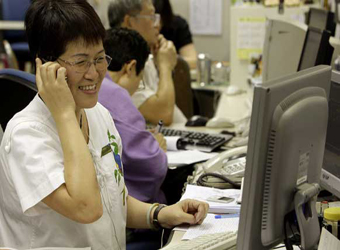In Sydney, the S&P/ASX 200 slipped back below the flat line to trade lower by 0.12 percent. Gains in the telecommunications space were offset by declines in the health care and heavily-weighted financials sub-indexes, which lost 0.64 percent and 0.32 percent, respectively.
Gold producer stocks rose 1.18 percent as the yellow metal held onto gains made last week. Kingsgate rose 3.75 percent and Newcrest added 1.36 percent.
Elsewhere, South Korean markets carved out slight gains following geopolitical developments regarding North Korea in the past week. The benchmark Kospi index tacked on 0.24 percent as technology stocks mostly gained while automakers fell. Heavyweights Samsung Electronics and SK Hynix edged up 0.35 percent and 0.39 percent, respectively, while Hyundai Motor declined 2.24 percent.
North Korean leader Kim Jong Un had declared his country a nuclear power during his New Year’s Day address on Monday, but also acknowledged that he was “open to dialogue” with the South, Reuters reported. Last week, South Korea seized a second vessels suspected of violating sanctions by smuggling oil to North Korea.
The positive sentiment was also seen in greater China markets. Hong Kong’s Hang Seng Index soared 1.55 percent as property and banking shares popped. Sunac rose 9.58 percent, Country Garden advanced 9.26 percent and China Evergrande Group added 5.38 percent in morning trade.
The Hang Seng outperformed other major Asian markets in 2017, rising 36 percent in the past year alone.
Mainland markets also saw increases: The Shanghai Composite rose 0.86 percent and the Shenzhen Composite was higher by 0.44 percent.
The Caixin manufacturing PMI, which focuses on activity at smaller businesses, for December released Tuesday came in at 51.5, topping the 50.6 figure forecast in a Reuters poll. The strong showing, which touched a four-month high, was attributed to solid output and new orders.
The official manufacturing Purchasing Managers’ Index (PMI) released last week had come in at 51.6 for the month of December, meeting analyst expectations, Reuters said.
Markets in Japan, New Zealand and Thailand were closed for holidays.
Equities in the region had run up significantly last year, with MSCI’s broad index of shares in Asia Pacific excluding Japan finishing the year with gains of more than 30 percent.
Wall Street closed slightly lower in the last trading session of 2017, with the Dow Jones industrial average declining 0.48 percent, or 118.29 points, to close at 24,719.22.
Still, major U.S. indexes recorded substantial gains for the year. The Dow Jones increased 25.2 percent last year and the benchmark S&P 500 rose 19.5 percent.
European markets were a similar story, with most indexes closing lower on Friday, but notching the largest annual gains since 2013 on average.
In currencies, the greenback was on the back foot against a basket of six currencies, with the dollar index trading at 92.188 at 10:10 a.m. HK/SIN. The index had notched its largest annual fall since 2003 on Friday.
Against the yen, the dollar traded at 112.71.
Meanwhile, the Australian dollar extended gains made before the new year, with the currency last trading at $0.7821. The Aussie dollar has been supported by the weaker greenback as well as strong commodity prices.
On the energy front, oil prices added to gains after the prior session saw U.S. crude close above the $60 barrier for the first time since the middle of 2015.
Brent crude futures edged up 0.42 percent to trade at $67.15 per barrel. U.S. West Texas Intermediate rose 0.28 percent to hold above the $60 mark at $60.59.
In other economic news, Singapore’s economy grew 3.1 percent in the fourth quarter compared to the previous year and 2.8 percent compared to the last quarter, advance estimates from the government showed. Quarterly growth came in a touch below the 2.9 percent median estimate in a Reuters survey. Source: CNBC
Source: CNBC
